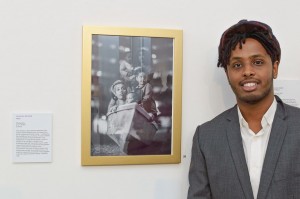Capturing diversity through a camera lens

Photographer: Abdullahi Ibrahim
A ground-breaking photographic project to capture the rich cultural diversity of Australia’s public housing estates has been launched in Melbourne.
Photographer Abdullahi Ibrahim and a collaborator have begun photographing people living in public housing – starting in suburban Carlton, where they grew up.
“We want to try to capture the essence of the commission flats and government housing. Not many people have experienced what it’s like to live in public housing,” Abdullahi said.
“We plan to go around Australia taking interesting photographs that will tell a story. For me, partly, it’s an exercise in nostalgia because I grew up in public housing and I’ve always valued the sense of community where I lived and the amazing diversity. Everyone has a story about how they got there and I want to develop a narrative around that idea,” Abdullahi said.
He said that Australia had a very rich history of public housing and the onset of gentrification in inner city areas could see that history and cultural richness lost.
The Housing Commission of Victoria was established by the Housing Act of 1937 in response to slum housing in Melbourne, and worked under the Slum Reclamation and Housing Act 1938. The mission was “slum abolition” driven by the zeal of social reformers, but later became referred to “slum clearance” and “block demolition”.
The Commission presided over the construction of the Melbourne Olympic Village in 1956, and made its mark on the Melbourne skyline during the 1960s in the form of high-rise blocks of flats on various sites around inner Melbourne, the largest of which were in Lygon Street in Carlton and Atherton Gardens in Fitzroy.
Approximately twenty of these precast concrete 20 to 30 storey height buildings were constructed around Melbourne, until the type of development fell into disrepute, mainly for sociological reasons. By 1970 nearly 4000 privately owned dwellings had been compulsorily acquired and replaced by nearly 7000 high rise flats.
“We want to capture the rawness and the essence of these places before it’s too late. It’s about capturing images of real people and telling their stories. It’s also about letting people tell their own stories through the images,” Abdullahi said.
“The plan is to go to different commission flats and capture different angles and local stories – and we’re not sugar-coating this, we understand the issues that exist in some of these places,” he said.
After fleeing the civil war in his home town of Mogadishu, Somalia, in 1991, Abdullahi and his family spent years in refugee camps in Kenya and Yemen.
He came to Australia aged five as a refugee in 1995 with his mother, elder brother and twin sister. The family settled in housing commission flats on Rathdowne Street, in Carlton.
Abdullahi attended the local primary school and Northcote High and is now in his second year studying chemical engineering at RMIT University.
But photography is his passion and something he would like to eventually take up professionally. Abdullahi was a finalist in the AMES/MAV 2013 Heartlands Refugee Art Prize with a photograph titled ‘Here!’ depicting family members in a small boat.
“Photography started as a hobby for me and through a kind of organic process it gradually developed into something more – it’s a way of experimenting and expressing myself,” Abdullahi said.
“I heard about the Heartlands competition and at the time I was interested in images around my environment so I thought I would enter one.
“The image shows a boat built by a local community group – a replica of a native American boat – and some of my family members,” he said.
Abdullahi volunteers as a youth counsellor at the community group Drummond Street Services and the boat was built over a year as one of the organisation’s youth projects.
“The boat project was designed to engage local kids and teach them some skills,” he said.
“The boat image tells a story and ultimately that is what interests me about photography – the opportunity to tell stories that transcend language and culture,” Abdullahi said.













